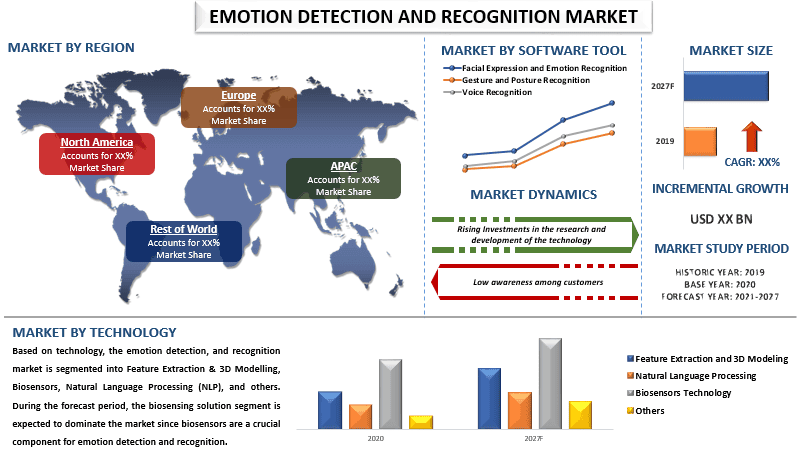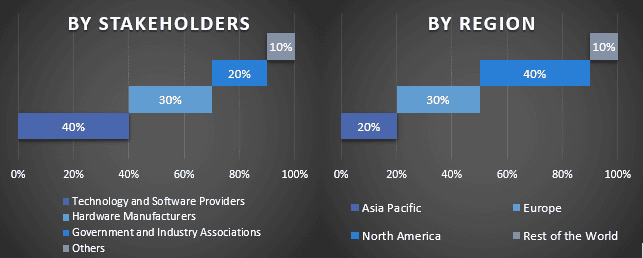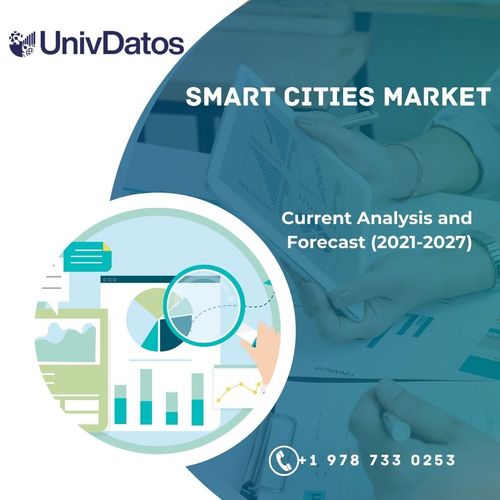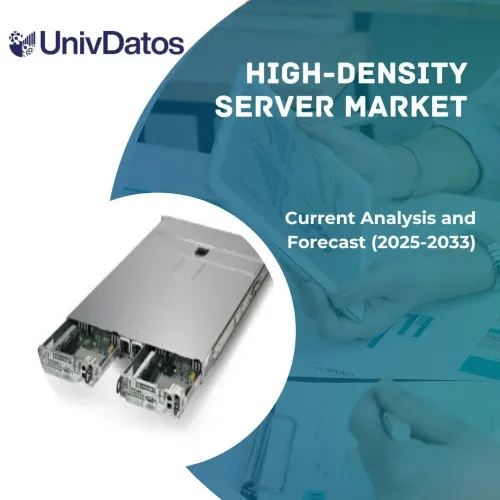Рынок обнаружения и распознавания эмоций: текущий анализ и прогноз (2021-2027)
Акцент на технологиях (извлечение признаков и 3D-моделирование, биосенсоры, обработка естественного языка (NLP) и другие); Программные инструменты (распознавание выражений лица и эмоций, распознавание жестов и поз, распознавание голоса); Области применения (маркетинг и реклама, правоохранительные органы, наблюдение и мониторинг, развлечения и потребительская электроника, другие); Регион/Страна.

Рынок обнаружения и распознавания эмоций получает распространение, поскольку он помогает в обнаружении человеческих эмоций с использованием технологических возможностей, таких как распознавание лиц, речи и голоса, биосенсорика, машинное обучение и распознавание образов.Рынок обнаружения и распознавания эмоцийожидается, что он будет расти со среднегодовым темпом роста в 15% в течение прогнозируемого периода из-за огромного расширения IoT, увеличения внедрения носимых технологий и массового увеличения использования смартфонов.Рынок может извлечь выгоду из использования облачных технологий в сочетании с другими ключевыми факторами, влияющими на рынок, включая растущую потребность в улучшении качества обслуживания клиентов (поскольку эмоциональная связь также играет ключевую роль наряду с удовлетворенностью клиентов), растущую потребность в человеческом отношении в цифровых коммуникациях (чат-боты) и проблемы контекста языка и распознавания лиц.
Кроме того, многие известные организации в различных отраслях, таких как технологии, автомобилестроение, потребительские товары и медиа и реклама, среди прочих, используют обнаружение и распознавание эмоций в своих интересах. Эта технология облегчает обнаружение поведения потребителей и, таким образом, способствует значительному вкладу в исследования поведения потребителей. Например, Disney использует технологию для определения того, как зрители наслаждаются его фильмами, в частности, создавая алгоритм на основе искусственного интеллекта, который может распознавать сложные выражения лица и даже предсказывать предстоящие эмоции.
Информация, представленная в отчете
«Ожидается, что среди программных инструментов сегмент распознавания выражений лица и эмоций будет демонстрировать самый высокий среднегодовой темп роста в течение прогнозируемого периода»
Основываясь на программном инструменте, рынок сегментирован на распознавание выражений лица и эмоций, распознавание жестов и поз и распознавание голоса. Ожидается, что сегмент распознавания жестов и поз будет расти самыми высокими темпами в течение прогнозируемого периода, поскольку он предлагает возможность естественного общения с технологией с помощью базового языка жестов, уменьшает использование наиболее распространенных аппаратных устройств и обеспечивает хорошую производительность с быстрыми и мощными результатами.
«Ожидается, что среди областей применения сегмент рекламы и маркетинга будет демонстрировать самый высокий среднегодовой темп роста в течение прогнозируемого периода»
По областям применения рынок сегментирован на маркетинг и рекламу, правоохранительные органы, наблюдение и мониторинг, потребительскую электронику и другие. Ожидается, что маркетинг и реклама будут доминировать на рынке решений для обнаружения и распознавания эмоций. Знание того, что чувствуют клиенты, стало ключевой целью любого бизнеса, компании должны осознавать точку зрения клиента, поскольку это помогает им соответствующим образом рекламировать. Развертывание технологии обнаружения и распознавания эмоций в маркетинге и рекламе бизнеса является ключом к изучению точки зрения клиента.
«Ожидается, что Северная Америка продемонстрирует значительный рост в течение прогнозируемого периода»
Ожидается, что Северная Америка достигнет самого высокого среднегодового темпа роста в течение прогнозируемого периода из-за присутствия ключевых игроков рынка в развитых странах, таких как Соединенные Штаты и Канада. Кроме того, стратегические инвестиции, партнерства и значительные расходы на исследования и разработки (R&D) передового оборудования и программного обеспечения способствуют существенному развертыванию решений для обнаружения и распознавания эмоций в регионе. Соединенные Штаты являются одним из крупнейших розничных рынков в мире и составляют значительную часть мировой розничной торговли, включая электронную коммерцию. По мере стремительного роста розничных продаж розничные торговцы в регионе все больше тратят на рекламу, ориентированную на нужные сегменты. Увеличение продаж позволяет розничным торговцам больше тратить на технологии, которые обеспечивают такие функции.
Причины купить этот отчет:
- Исследование включает в себя анализ размеров рынка и прогнозирования, подтвержденный проверенными ключевыми отраслевыми экспертами.
- Отчет представляет собой краткий обзор общей производительности отрасли с первого взгляда.
- Отчет содержит углубленный анализ видных отраслевых коллег с основным упором на ключевые финансовые показатели бизнеса, портфели продуктов, стратегии расширения и недавние разработки.
- Подробное изучение движущих сил, ограничений, ключевых тенденций и возможностей, преобладающих в отрасли.
- Исследование всесторонне охватывает рынок по различным сегментам.
- Углубленный анализ отрасли на региональном уровне.
Варианты настройки:
Глобальный рынок обнаружения и распознавания эмоций может быть дополнительно настроен в соответствии с требованиями или любым другим сегментом рынка. Кроме того, UMI понимает, что у вас могут быть свои собственные потребности бизнеса, поэтому не стесняйтесь обращаться к нам, чтобы получить отчет, который полностью соответствует вашим требованиям.
Содержание
Методология исследования для анализа глобального рынка обнаружения и распознавания эмоций (2021-2027)
Анализ исторического рынка, оценка текущего рынка и прогнозирование будущего рынка глобального рынка обнаружения и распознавания эмоций были тремя основными шагами, предпринятыми для создания и анализа внедрения обнаружения и распознавания эмоций в основных регионах мира. Были проведены исчерпывающие вторичные исследования для сбора исторических рыночных показателей и оценки текущего размера рынка. Во-вторых, чтобы подтвердить эти выводы, были приняты во внимание многочисленные результаты и предположения. Кроме того, были проведены исчерпывающие первичные интервью с отраслевыми экспертами по всей цепочке создания стоимости глобального рынка обнаружения и распознавания эмоций. После предположения и проверки рыночных показателей посредством первичных интервью мы применили восходящий/нисходящий подход для прогнозирования общего размера рынка. После этого были приняты методы разбивки рынка и триангуляции данных для оценки и анализа размера рынка сегментов и подсегментов отрасли.
Анализ исторического размера рынка
Шаг 1: Углубленное изучение вторичных источников:
Подробное вторичное исследование было проведено для получения исторических размеров рынка обнаружения и распознавания эмоций через внутренние источники компании, такие какгодовые отчеты и финансовые отчеты, презентации о результатах деятельности, пресс-релизы и т. д.,и внешние источники, включаяжурналы, новости и статьи, правительственные публикации, публикации конкурентов, отраслевые отчеты, сторонние базы данных и другие авторитетные публикации.
Шаг 2: Сегментация рынка:
После получения исторических размеров рынка обнаружения и распознавания эмоций мы провели подробный вторичный анализ для сбора исторических рыночных данных и долей для различных сегментов и подсегментов для основных регионов. Основные сегменты включены в отчет как технология, программный инструмент и области применения. Дальнейший анализ на уровне стран был проведен для оценки общего внедрения моделей тестирования в этом регионе.
Шаг 3: Факторный анализ:
После получения исторических размеров рынка различных сегментов и подсегментов мы провели подробныйфакторный анализдля оценки текущего размера рынка обнаружения и распознавания эмоций. Далее мы провели факторный анализ с использованием зависимых и независимых переменных, таких как различные технологии, программные инструменты и области применения обнаружения и распознавания эмоций. Был проведен тщательный анализ сценариев спроса и предложения с учетом ведущих партнерств, слияний и поглощений, расширения бизнеса, а также запуска программного обеспечения и услуг в секторе обнаружения и распознавания эмоций по всему миру.
Оценка и прогноз текущего размера рынка
Оценка текущего размера рынка:Основываясь на практических выводах из вышеуказанных 3 шагов, мы пришли к текущему размеру рынка, ключевым игрокам на глобальном рынке обнаружения и распознавания эмоций и рыночным долям сегментов. Все необходимые доли в процентах, разделения и разбивки рынка были определены с использованием вышеупомянутого вторичного подхода и были проверены посредством первичных интервью.
Оценка и прогнозирование:Для оценки и прогнозирования рынка веса были присвоены различным факторам, включая драйверы и тенденции, ограничения и возможности, доступные для заинтересованных сторон. После анализа этих факторов были применены соответствующие методы прогнозирования, т. е. восходящий/нисходящий подход, для получения прогноза рынка на 2027 год для различных сегментов и подсегментов на основных рынках мира. Методология исследования, принятая для оценки размера рынка, включает в себя:
- Размер рынка отрасли с точки зрения выручки (USD) и скорость внедрения рынка обнаружения и распознавания эмоций на основных рынках внутри страны
- Все процентные доли, разделения и разбивки сегментов и подсегментов рынка
- Ключевые игроки на глобальном рынке обнаружения и распознавания эмоций с точки зрения предлагаемых решений. Кроме того, стратегии роста, принятые этими игроками для конкуренции на быстрорастущем рынке
Проверка размера и доли рынка
Первичные исследования:Углубленные интервью были проведены с ключевыми лидерами мнений (KOL), включая руководителей высшего звена (CXO/VP, руководитель отдела продаж, руководитель отдела маркетинга, руководитель отдела эксплуатации, региональный руководитель, руководитель страны и т. д.) во всех основных регионах. Результаты первичных исследований были затем обобщены, и был проведен статистический анализ для доказательства заявленной гипотезы. Данные первичных исследований были объединены с вторичными данными, таким образом, превращая информацию в практические выводы.
Разделение основных участников по различным регионам

Инженерное дело рынка
Метод триангуляции данных был использован для завершения общей оценки рынка и получения точных статистических данных для каждого сегмента и подсегмента глобального рынка обнаружения и распознавания эмоций. Данные были разделены на несколько сегментов и подсегментов после изучения различных параметров и тенденций в областях технологий, программных инструментов и приложений на глобальном рынке обнаружения и распознавания эмоций.
Основная цель исследования глобального рынка обнаружения и распознавания эмоций
В исследовании были определены текущие и будущие тенденции рынка глобального рынка обнаружения и распознавания эмоций. Инвесторы могут получить стратегические идеи для обоснования своих решений по инвестициям на основе качественного и количественного анализа, проведенного в исследовании. Текущие и будущие тенденции рынка определили общую привлекательность рынка на региональном уровне, обеспечивая платформу для участников отрасли для использования неиспользованного рынка, чтобы получить выгоду от преимущества первого участника. Другие количественные цели исследований включают:
- Проанализировать текущий и прогнозируемый размер рынка обнаружения и распознавания эмоций в стоимостном выражении (долл. США). Кроме того, проанализировать текущий и прогнозируемый размер рынка различных сегментов и подсегментов
- Сегменты исследования включают области технологий, программных инструментов и приложений.
- Определение и анализ нормативно-правовой базы для отрасли рынка обнаружения и распознавания эмоций.
- Анализ цепочки создания стоимости с участием различных посредников, а также анализ поведения клиентов и конкурентов отрасли.
- Проанализировать текущий и прогнозируемый размер рынка обнаружения и распознавания эмоций для основных регионов.
- Основные страны регионов, изученные в отчете, включают Азиатско-Тихоокеанский регион, Европу, Северную Америку и Остальной мир.
- Профили компаний рынка обнаружения и распознавания эмоций и стратегии роста, принятые участниками рынка для поддержания устойчивого роста на быстрорастущем рынке
- Углубленный анализ отрасли на региональном уровне
Связанные Отчеты
Клиенты, купившие этот товар, также купили










